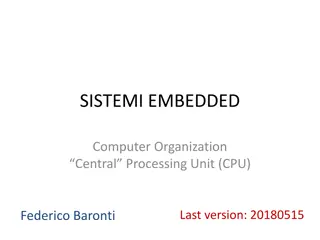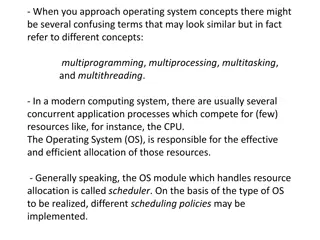Illustrated Design of a Simplified CPU with 16-bit RAM
Demonstrates the design of a basic CPU with 11 instructions and 4096 16-bit RAM, showcasing the assembly of a general-purpose computer using gates and registers. The CPU comprises 8 key registers for various functions, employing a sequential circuit for instruction execution. The machine language program consists of instructions with opcodes and addresses, utilizing a 4-bit opcode format and 12-bit memory addressing. The fetch-and-execute cycle of the CPU involves fetching instructions based on the program counter and executing actions accordingly, with examples like loading the accumulator elaborated.
Download Presentation

Please find below an Image/Link to download the presentation.
The content on the website is provided AS IS for your information and personal use only. It may not be sold, licensed, or shared on other websites without obtaining consent from the author.If you encounter any issues during the download, it is possible that the publisher has removed the file from their server.
You are allowed to download the files provided on this website for personal or commercial use, subject to the condition that they are used lawfully. All files are the property of their respective owners.
The content on the website is provided AS IS for your information and personal use only. It may not be sold, licensed, or shared on other websites without obtaining consent from the author.
E N D
Presentation Transcript
Design of a Simple CPU 11-instruction CPU with 212 (4096) 16-bit RAM. Illustrates how a general-purpose computer is assembled from gates and registers. The design is simplified to make basic concepts clear. CPU design can be very complex. Since the CPU is the heart of every computer, emphasis is put on making it fast. November 2013 Simple CPU Design 1
The Register Set A CPU is a sequential circuit repeatedly reads and executes an instruction from its memory fetch-and-execute cycle A machine language program is a set of instructions drawn from the CPU instruction set Each instruction consists of two parts: an opcode and an address November 2013 Simple CPU Design 2
11 instructions require a 4-bit opcode. 12 bits of the 16-bit word remain for addressing 212 = 4096 16-bit words of the RAM. The CPU has 8 special registers: 16-bit accumulator(AC) 12-bit program counter (PC) 4-bit opcode(OPC) 12-bit memory address register (MAR) 16-bit memory data register (MDR) 16-bit input register (INR) 16-bit output register (OUTR) 1-bithalt register (HLT) November 2013 Simple CPU Design 3
The Registers Data Transfer in the CPU November 2013 Simple CPU Design 4
The Fetch-and-Execute Cycle Fetch-and-execute cycle has two portions Fetch portion is always the same: instruction, whose address is in the PC, is fetched into the MDR opcode portion of this register is copied into the OPC At this point the action of the CPU diverges, based on the instruction in OPC November 2013 Simple CPU Design 5
Suppose OPC is a load accumulator instruction. the action required is to copy the word specified by the address part of the instruction into the accumulator load accumulator is decomposed into 8 microinstructions executed in 6 microcycles November 2013 Simple CPU Design 6
The Instruction Set November 2013 Simple CPU Design 7
Other operations can be performed using this set: subtraction is realized with ADD, CMA, and 2 s comp multiplication is possible through the use of CIL and ADD multiple CILs can be used to rotate right one place, hence division is also possible AND and CMA are complete Boolean system, hence every Boolean function can be realized by this machine if it is designed to address enough memory locations November 2013 Simple CPU Design 8
Direct memory instruction Addresses refer directly to memory locations containing the operands(data) on which the program operates Indirect memory instructions Instructions in which an address is interpreted as the address at which to find the address containing the needed operand CPU does two memory fetches the first to find the address of the operand the second to find the operand itself November 2013 Simple CPU Design 9
Assembly-Language Programming Instructions stored in memory consist of 16 bits. the first 4 are opcode and the last 12 are address It is hard to interpret such machine-language statements. mnemonic opcodes and assembly languages are devised Assembleris a program translating an assembly language program into a machine language. November 2013 Simple CPU Design 10
Example: a Boot Program Assembly-language program to boot up a computer is reading another program provided through the input port and stores the new program (16-bit words) in memory just above Boot. When reading is finished (determined by 0 word), control is transferred to the new program by jumping to the first location above Boot. November 2013 Simple CPU Design 11
0 1 2 3 4 5 6 7 8 9 November 2013 Simple CPU Design 12
The 1st instruction following the ORG statement reads the input register value into the accumulator. The 2nd instruction jumps to address 10 if AC==0, indicating that the last word of the program being loaded has been written into the memory. The next executed instruction is in address 10; control is transferred to the second program. November 2013 Simple CPU Design 13
If AC!=0, its value is stored (indirectly) at an address (value) stored at ADDR_2 memory address. On the first execution of this command the value stored at memory address ADDR_2 is 10. The content of the accumulator is therefore stored at location 10. The next 3 steps increment by 1 the value of ADDR_2 by placing its contents in the accumulator, adding the value in memory address ADDR_3 (=1) to it and storing the new value into memory address ADDR_2. November 2013 Simple CPU Design 14
Finally, the accumulator is zeroed and a JZ instruction is used to return to ADDR_1 (=0), the first address of the boot program. address The indirect STA instruction is not supported by the simple computer, but can be simulated by a self-modifying subprogram. Though self-modifying programs are considered a bad programming practice, it illustrates the power of self- modification and the advantage of having indirection in the instruction set of a computer. November 2013 Simple CPU Design 15
Timing and Control We need to design circuits controlling the combining and movement of data. Assignment notation is introduced. November 2013 Simple CPU Design 16
Register transfer notation uses these assignment operations as well as timing information to break down a machine-level instruction into microinstructions that are executed in successive microcycles. November 2013 Simple CPU Design 17
microinstructions for the execute portion November 2013 Simple CPU Design 18
November 2013 Simple CPU Design 19
November 2013 Simple CPU Design 20
November 2013 Simple CPU Design 21
Generating Control Signals Define control variables that control the movement of data between registers or combine the contents of two registers and assign the result to another register. Associate a control variable L(A,B) if a microinstruction results in the movement of data from register B to register A, denoted A B. L(OPC,MDR) = t3 : OPC is loaded with the contents of MDR when t3 = 1 November 2013 Simple CPU Design 22
Associate a control variable L(A,B C) if a microinstruction results in the combination of the contents of registers B and C with the operation and the assignment of the result to register A, denoted A B C. L(AC, AC+MDR) = cADD t6 : The content of AC is added to thath of MDR and copied into AC when cADD t6 = 1. November 2013 Simple CPU Design 23
Control of Accumulator Group together all the microinstructions affecting accumulator Derive control variables November 2013 Simple CPU Design 24
Hardware Implementation 16 7:1 MUXes LSB: 0 MSB: 15 MUX 7:1 MUX 7:1 16-bit zero 16-bit ALU ADD AND NOT 16-bit registers LSB: 0 14 MSB: 15 November 2013 Simple CPU Design 25
Execution of LSB: 0 MSB: 15 MUX 7:1 MUX 7:1 ADD AND NOT LSB: 0 14 MSB: 15 November 2013 Simple CPU Design 26
Execution of AC Shift(AC) LSB: 0 MSB: 15 MUX 7:1 MUX 7:1 ADD AND NOT LSB: 0 14 MSB: 15 November 2013 Simple CPU Design 27
Group together all the microinstructions affecting MAR Derive control variables November 2013 Simple CPU Design 28
Group together all the microinstructions affecting MDR Derive control variables Quiz: What and how many MUXes are required? Ans: 16 MUXes of 2:1 November 2013 Simple CPU Design 29
Group together all the microinstructions affecting register a given Derive control variables November 2013 Simple CPU Design 30
Group together all the microinstructions affecting register a given Derive control variables November 2013 Simple CPU Design 31























